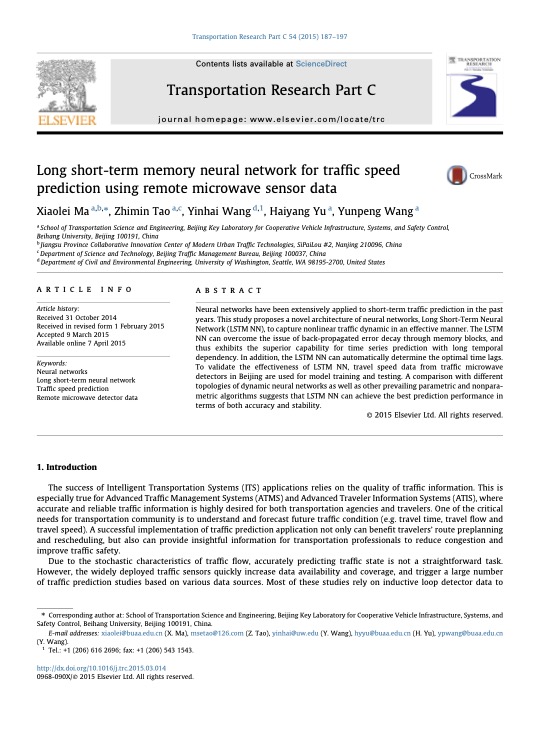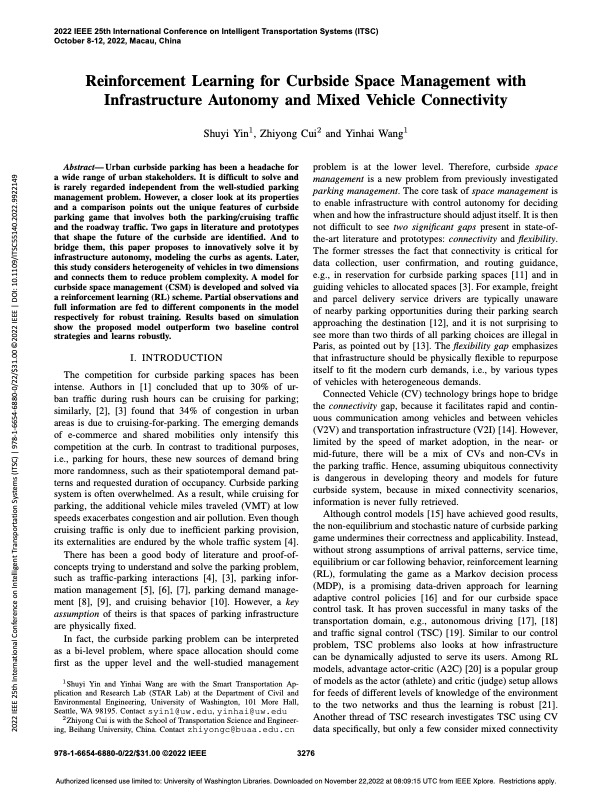About
Founded in 2003, the Smart Transportation Applications & Research (STAR) Lab has been a leading research and education group in intelligent transportation systems (ITS) at the Civil and Environmental Engineering Department of University of Washington. Our sponsors range from national programs (e.g., NCHRP by TRB, FHWA, FTA, Norwegian Public Roads Administration), to University Transportation Centers (PacTrans and CSET), to all levels of agencies (e.g., WSDOT, SDOT), and to the private sector. Our pioneers are always exploring effective solutions for a safe, efficient, and intelligent transportation system. Read more about our mission and objectives here >>
Research Areas
Highlight Projects
People
Highlighted Publications
- DTraffic Prediction
- SSensing on the Edge
- CCAV Behavior & Impacts
- ISmart Infrastructure
- OTraffic Safety Modeling

Graph Markov network for traffic forecasting with missing data
In this study, we consider the traffic network as a graph and define the transition between network-wide traffic states at consecutive time steps as a graph Markov process. In this way, missing traffic states can be inferred step by step and the spatial–temporal relationships among the roadway links can be incorporated. Based on the graph Markov process, we propose a new neural network architecture for spatial–temporal data forecasting, i.e. the graph Markov network (GMN). By incorporating the spectral graph convolution operation, we also propose a spectral graph Markov network (SGMN). The proposed models are compared with baseline models and tested on three real-world traffic state datasets with various missing rates. Experimental results show that the proposed GMN and SGMN can achieve superior prediction performance in terms of both accuracy and efficiency. Besides, the proposed models’ parameters, weights, and predicted results are comprehensively analyzed and visualized.
Cui, Z., Lin, L., Pu, Z., & Wang, Y. (2020). Graph Markov network for traffic forecasting with missing data. Transportation Research Part C: Emerging Technologies, 117, 102671.

Long short-term memory neural network for traffic speed prediction using remote microwave sensor data
Neural networks have been extensively applied to short-term traffic prediction in the past years. This study proposes a novel architecture of neural networks, Long Short-Term Neural Network (LSTM NN), to capture nonlinear traffic dynamic in an effective manner. The LSTM NN can overcome the issue of back-propagated error decay through memory blocks, and thus exhibits the superior capability for time series prediction with long temporal dependency. In addition, the LSTM NN can automatically determine the optimal time lags. To validate the effectiveness of LSTM NN, travel speed data from traffic microwave detectors in Beijing are used for model training and testing. A comparison with different topologies of dynamic neural networks as well as other prevailing parametric and nonparametric algorithms suggests that LSTM NN can achieve the best prediction performance in terms of both accuracy and stability.
Ma, X., Tao, Z., Wang, Y., Yu, H., & Wang, Y. (2015). Long short-term memory neural network for traffic speed prediction using remote microwave sensor data. Transportation Research Part C: Emerging Technologies, 54, 187-197.

Edge Computing for Real-Time Near-Crash Detection for Smart Transportation Applications
In this study, we consider the traffic network as a graph and define the transition between network-wide traffic states at consecutive time steps as a graph Markov process. In this way, missing traffic states can be inferred step by step and the spatial–temporal relationships among the roadway links can be incorporated. Based on the graph Markov process, we propose a new neural network architecture for spatial–temporal data forecasting, i.e. the graph Markov network (GMN). By incorporating the spectral graph convolution operation, we also propose a spectral graph Markov network (SGMN). The proposed models are compared with baseline models and tested on three real-world traffic state datasets with various missing rates. Experimental results show that the proposed GMN and SGMN can achieve superior prediction performance in terms of both accuracy and efficiency. Besides, the proposed models’ parameters, weights, and predicted results are comprehensively analyzed and visualized.
Ke, R., Cui, Z., Chen, Y., Zhu, M., Yang, H., & Wang, Y. (2020). Edge Computing for Real-Time Near-Crash Detection for Smart Transportation Applications. arXiv preprint arXiv:2008.00549.

Safe, efficient, and comfortable velocity control based on reinforcement learning for autonomous driving
A model used for velocity control during car following is proposed based on reinforcement learning (RL). To optimize driving performance, a reward function is developed by referencing human driving data and combining driving features related to safety, efficiency, and comfort. With the developed reward function, the RL agent learns to control vehicle speed in a fashion that maximizes cumulative rewards, through trials and errors in the simulation environment. To avoid potential unsafe actions, the proposed RL model is incorporated with a collision avoidance strategy for safety checks. The safety check strategy is used during both model training and testing phases, which results in faster convergence and zero collisions. A total of 1,341 car-following events extracted from the Next Generation Simulation (NGSIM) dataset are used to train and test the proposed model. The performance of the proposed model is evaluated by the comparison with empirical NGSIM data and with adaptive cruise control (ACC) algorithm implemented through model predictive control (MPC). The experimental results show that the proposed model demonstrates the capability of safe, efficient, and comfortable velocity control and outperforms human drivers in that it 1) has larger TTC values than those of human drivers, 2) can maintain efficient and safe headways around 1.2s, and 3) can follow the lead vehicle comfortably with smooth acceleration (jerk value is only a third of that of human drivers). Comparedwith the MPC-based ACC algorithm, the proposed model has better performance in terms of safety, comfort, and especially running speed during testing (more than 200 times faster). The results indicate that the proposed approach could contribute to the development of better autonomous driving systems. Source code of this paper can be found at https://github.com/MeixinZhu/Velocity_control.
Zhu, M., Wang, Y., Pu, Z., Hu, J., Wang, X., & Ke, R. (2020). Safe, efficient, and comfortable velocity control based on reinforcement learning for autonomous driving. Transportation Research Part C: Emerging Technologies, 117, 102662.

Toward a Dynamic Reversible Lane Management Strategy by Empowering Learning-Based Predictive Assignment Scheme
Reversible lanes have been used worldwide on various road types to mitigate the effects of congestion and optimize mobility. This paper introduces a Predictive Empowered Assignment Scheme for Reversible Lane (PEARL). By integrating the advanced traffic flow prediction module and bi-level optimization model, PEARL is a more flexible dynamic lane assignment strategy with foresight compared to traditional lane management methods. The prediction module of PEARL predicts short-term traffic with Bi-directional LSTM with historical sequence, real-time data, and the environmental conditions in the region as input. Then, the total throughput in both directions are maximized while the total user costs are minimized in the bi-leveloptimization module. The iterations on the prediction module and optimization module can help PEARL coordinate the future lane control plan and make the best decision.
Liu, C., Yang, H., Ke, R., & Wang, Y. (2022). Toward a Dynamic Reversible Lane Management Strategy by Empowering Learning-Based Predictive Assignment Scheme. IEEE Transactions on Intelligent Transportation Systems.

Reinforcement Learning for Curbside Space Management with Infrastructure Autonomy and Mixed Vehicle Connectivity
Urban curbside parking has been a headache for a wide range of urban stakeholders. It is difficult to solve and is rarely regarded independent from the well-studied parking management problem. However, a closer look at its properties and a comparison points out the unique features of curbside parking game that involves both the parking/cruising traffic and the roadway traffic. Two gaps in literature and prototypes that shape the future of the curbside are identified. And to bridge them, this paper proposes to innovatively solve it by infrastructure autonomy, modeling the curbs as agents. Later, this study considers heterogeneity of vehicles in two dimensions and connects them to reduce problem complexity. A model for curbside space management (CSM) is developed and solved via a reinforcement learning (RL) scheme. Partial observations and full information are fed to different components in the model respectively for robust training. Results based on simulation show the proposed model outperform two baseline strategies and learns robustly.
Yin, S., Cui, Z., & Wang, Y. (2022, October). Reinforcement Learning for Curbside Space Management with Infrastructure Autonomy and Mixed Vehicle Connectivity. In 2022 IEEE 25th International Conference on Intelligent Transportation Systems (ITSC) (pp. 3276-3282). IEEE.

Estimating the risk of collisions between bicycles and motor vehicles at signalized intersections
Collisions between bicycles and motor vehicles have caused severe life and property losses in many countries. The majority of bicycle–motor vehicle (BMV) accidents occur at intersections. In order to reduce the number of BMV accidents at intersections, a substantial understanding of the causal factors for the collisions is required. In this study, intersection BMV accidents were classified into three types based on the movements of the involved motor vehicles and bicycles. The three BMV accident classifications were through motor vehicle related collisions, left-turn motor vehicle related collisions, and right-turn motor vehicle related collisions. A methodology for estimating these BMV accident risks was developed based on probability theory. A significant difference between this proposed methodology and most current approaches is that the proposed approach explicitly relates the risk of each specific BMV accident type to its related flows. The methodology was demonstrated using a 4-year (1992–1995) data set collected from 115 signalized intersections in the Tokyo Metropolitan area. This data set contains BMV accident data, bicycle flow data, motor vehicle flow data, traffic control data, and geometric data for each intersection approach. For each BMV risk model, an independent explanatory variable set was chosen according to the characteristics of the accident type. Three negative binomial regression models (one corresponding to each BMV accident type) were estimated using the maximum likelihood method. The coefficient value and its significance level were estimated for each selected variable. The negative binomial dispersion parameters for all the three models were significant at 0.01 levels. This supported the choice of the negative binomial regression over the Poisson regression for the quantitative analyses in this study
Wang, Y., & Nihan, N. L. (2004). Estimating the risk of collisions between bicycles and motor vehicles at signalized intersections. Accident Analysis & Prevention, 36(3), 313-321.


